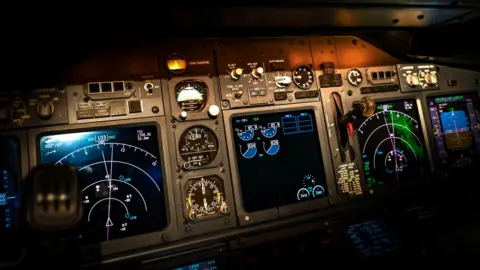In the wake of the tragic Air India crash that claimed at least 270 lives shortly after take-off, focus has shifted to the Boeing 787 Dreamliner, once heralded as one of the safest in the industry. Investigations are ongoing, with flight recorder data being examined in efforts to determine the cause of this recent calamity. Despite years of a flawless operational record, the 787 has faced scrutiny over several reported quality control issues, prompting concerns among aviation experts and the public alike.
Prior to the accident, Boeing’s 787 had flown safely for over 14 years, transporting more than a billion passengers and operating over 1,100 aircraft globally. However, former employees have come forth with serious accusations, suggesting that production practices might have compromised safety standards. These include claims of substandard parts being utilized in place of compliant ones in an attempt to expedite the manufacturing process.
The genesis of the 787 Dreamliner lies in the early 2000s when a growing demand for fuel-efficient long-range airplanes led Boeing to devise a revolutionary aircraft with advanced materials and aerodynamics. The ambitious project aimed to offer significant fuel savings over its predecessors, like the 767, and enabled a shift in airline business models from hub-to-hub flights to point-to-point services. Boeing’s innovative departure from traditional materials and designs positioned the 787 as a leader in operational efficiency, garnering praise and setting new industry standards.
However, issues began to surface not long after the aircraft entered service. Notably, incidents involving lithium-ion battery fires led to a temporary grounding of the fleet, raising questions about the safety and reliability of the aircraft. Production challenges surfaced following the establishment of a new assembly line in South Carolina, intended to streamline operations but which some analysts attribute to lapses in quality control.
Reports from whistleblowers have amplified these concerns. John Barnett, a former quality manager, highlighted alarming practices at the South Carolina factory, alleging pressure for faster production led to oversight on critical safety procedures, potentially endangering future flights. Barnett tragically took his own life earlier this year amid ongoing legal battles and continued efforts to highlight safety violations.
With fresh allegations emerging from current employees, including Sam Salehpour, warnings of potentially hazardous assembly shortcuts aligned with production deadlines have raised red flags regarding the structural integrity of the aircraft.
As the investigation into the Air India crash continues, the aviation sector remains watchful. Various organizations, including the Foundation for Aviation Safety, point to notable alarming trends regarding the 787 despite its historical safety record. While industry analysts express confidence that any significant issues would have emerged by this stage, the recent tragedy solidifies the case for intensified scrutiny of production standards within Boeing.
Ultimately, as the global aviation community awaits further developments in the investigation, trust in the Boeing 787 Dreamliner rests at a critical juncture, and only time will reveal the outcomes of these mounting concerns over air safety and manufacturing ethics.
Prior to the accident, Boeing’s 787 had flown safely for over 14 years, transporting more than a billion passengers and operating over 1,100 aircraft globally. However, former employees have come forth with serious accusations, suggesting that production practices might have compromised safety standards. These include claims of substandard parts being utilized in place of compliant ones in an attempt to expedite the manufacturing process.
The genesis of the 787 Dreamliner lies in the early 2000s when a growing demand for fuel-efficient long-range airplanes led Boeing to devise a revolutionary aircraft with advanced materials and aerodynamics. The ambitious project aimed to offer significant fuel savings over its predecessors, like the 767, and enabled a shift in airline business models from hub-to-hub flights to point-to-point services. Boeing’s innovative departure from traditional materials and designs positioned the 787 as a leader in operational efficiency, garnering praise and setting new industry standards.
However, issues began to surface not long after the aircraft entered service. Notably, incidents involving lithium-ion battery fires led to a temporary grounding of the fleet, raising questions about the safety and reliability of the aircraft. Production challenges surfaced following the establishment of a new assembly line in South Carolina, intended to streamline operations but which some analysts attribute to lapses in quality control.
Reports from whistleblowers have amplified these concerns. John Barnett, a former quality manager, highlighted alarming practices at the South Carolina factory, alleging pressure for faster production led to oversight on critical safety procedures, potentially endangering future flights. Barnett tragically took his own life earlier this year amid ongoing legal battles and continued efforts to highlight safety violations.
With fresh allegations emerging from current employees, including Sam Salehpour, warnings of potentially hazardous assembly shortcuts aligned with production deadlines have raised red flags regarding the structural integrity of the aircraft.
As the investigation into the Air India crash continues, the aviation sector remains watchful. Various organizations, including the Foundation for Aviation Safety, point to notable alarming trends regarding the 787 despite its historical safety record. While industry analysts express confidence that any significant issues would have emerged by this stage, the recent tragedy solidifies the case for intensified scrutiny of production standards within Boeing.
Ultimately, as the global aviation community awaits further developments in the investigation, trust in the Boeing 787 Dreamliner rests at a critical juncture, and only time will reveal the outcomes of these mounting concerns over air safety and manufacturing ethics.





















